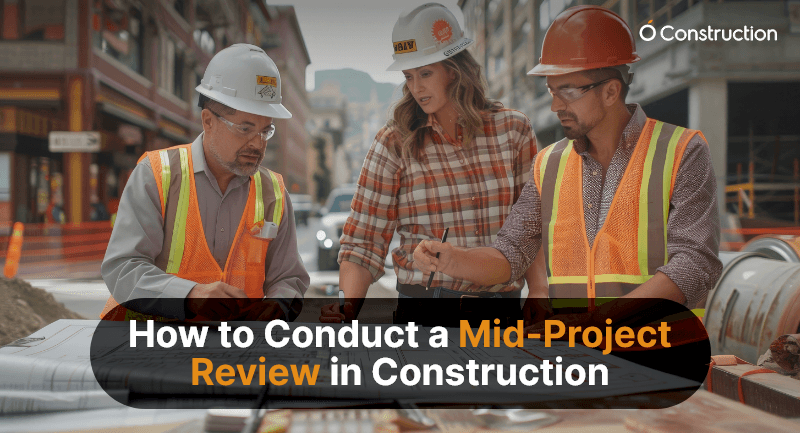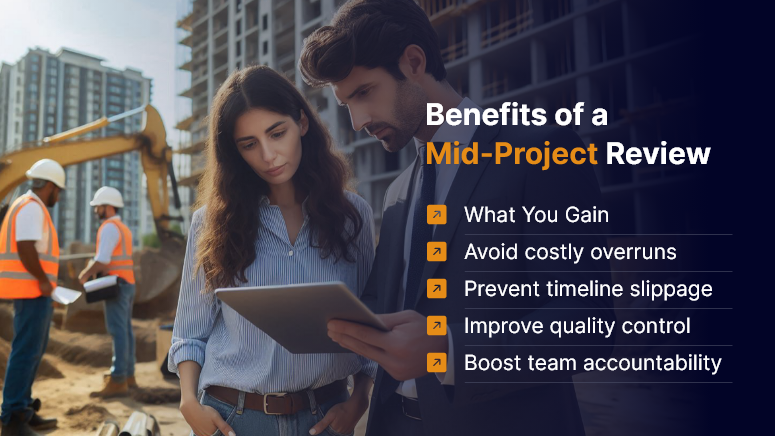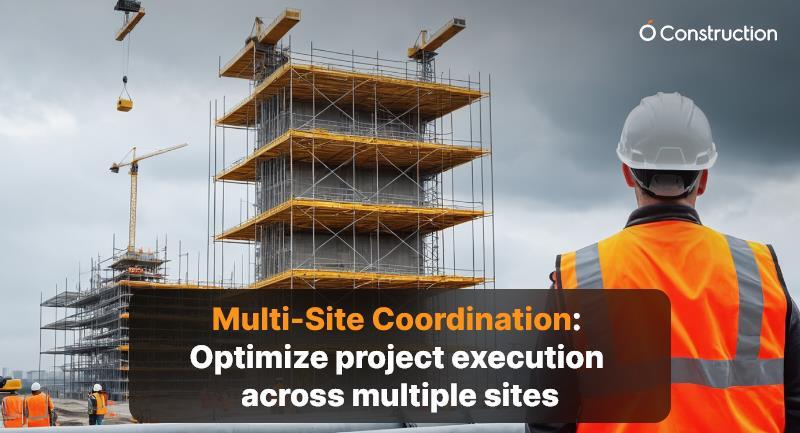In construction, the halfway point of a project is more than a milestone — it’s a reality check. According to a McKinsey report, large projects are typically 20% over schedule and up to 80% over budget by the end. Many of these issues could have been identified and corrected if a structured mid-project review in construction had been carried out.
This review isn’t just about ticking boxes — it’s about uncovering potential delays, budget overruns, and quality risks while there’s still time to fix them. In this guide, we’ll break down exactly how to conduct a successful mid-project review in construction, so you can keep your timelines, costs, and teams on track using the power of OConstruction’s integrated platform.
Why a Mid-Project Review in Construction Matters
Your construction schedule is not static—it’s a living, breathing roadmap. Without an intentional check-in, small deviations can grow into full-blown setbacks.
The Business Case for a Mid-Project Review
- Prevent Cost Overruns: Catch budget drift early by comparing planned vs. actual expenditures.
- Improve Timeline Accuracy: Identify schedule slippage before it impacts delivery.
- Enhance Quality Control: Ensure work meets specifications before it’s too late to correct.
Who Benefits Most?
- Project Managers get clarity on performance metrics.
- Contractors avoid rework and disputes with accurate reporting.
- Developers protect ROI by preventing late-stage surprises.
Pain vs. Solution Example:
- Without a mid-project review: Crews continue working without knowing critical tasks are delayed; materials arrive late; cost reports are outdated.
- With a mid-project review in construction: OConstruction’s dashboards show real-time cost, schedule, and quality metrics, allowing you to adjust plans instantly.
How to Conduct a Mid-Project Review in Construction: Step-by-Step
1. Set Clear Review Objectives
Define what you’re evaluating — costs, timelines, quality, safety, or all four.
Pro tip: In OConstruction, create a custom review checklist tied to live project data, so nothing is overlooked.
2. Gather Accurate Data
- Pull budget vs. actual reports.
- Review updated Gantt charts for schedule progress.
- Collect site inspection notes and safety records.
With OConstruction, all this data is centralized, thereby reducing the risk of errors associated with scattered spreadsheets.
3. Conduct Stakeholder Interviews
Speak with site supervisors, contractors, and suppliers to gain a deeper understanding of the challenges.
Best Practice: Use structured digital forms in OConstruction to capture feedback consistently across all teams.
4. Identify Variances and Root Causes
Look for deviations in budget, timelines, or quality.
- If costs are high, are material prices the cause?
- If timelines slip, are dependencies properly managed?
OConstruction’s dependency tracking makes cause-and-effect analysis simple.
5. Develop a Corrective Action Plan
Once issues are identified, assign responsibility and set deadlines for fixes. Use OConstruction’s task management feature to allocate follow-up actions and track them until completion.
6. Communicate Findings Clearly
Don’t let your review sit in a PDF nobody reads. Automate stakeholder updates directly from your OConstruction dashboard, ensuring everyone is aligned and accountable.
Customer Success Story
For example, HarborBuild Contractors, a mid-sized commercial builder, implemented their first mid-project review in construction using OConstruction. They discovered a 12% budget overrun risk due to underestimated subcontractor hours.
By adjusting workloads and renegotiating contracts mid-way, they:
- Saved $480,000 in projected overruns
- Reduced schedule delay risk by 3 weeks
- Improved subcontractor satisfaction through better coordination
The result? The project finished on time and 5% under budget, improving their bid success rate for future contracts.
Key Takeaways
A mid-project review in construction is your best insurance against late and over-budget deliveries.
Quick Recap:
- Be proactive – Schedule your review before issues escalate.
- Use accurate data – Centralized, real-time reporting is non-negotiable.
- Engage stakeholders – Consistent communication prevents surprises.
- Take action fast – A review is pointless without follow-through.
In short, the mid-project review is not just a checkpoint—it’s a powerful control mechanism. By combining structured evaluations with tools like OConstruction, you can pivot quickly, protect your budget, and maintain client trust.
FAQs
1. What is a mid-project review in construction?
A mid-project review is a structured evaluation conducted at the halfway point of a construction project. It examines budget, timelines, quality, and safety to identify potential risks early. Instead of waiting until final delivery, the review allows project teams to make corrections while there’s still time to avoid costly overruns or delays.
2. Why is a mid-project review important in construction projects?
Because construction projects are complex and dynamic, small delays or cost overruns can snowball into major setbacks. A mid-project review helps you catch these issues early, improve schedule accuracy, and ensure quality standards are being met. This proactive step protects ROI, improves accountability, and builds stronger client trust.
3. How does a mid-project review prevent cost overruns and delays?
By comparing planned vs. actual expenditures, analyzing updated schedules, and reviewing progress reports, teams can see where budgets are drifting or timelines are slipping. With corrective action plans in place, you can immediately address these issues, preventing further escalation.
4. Who should participate in a mid-project review?
Typically, project managers, contractors, site supervisors, engineers, and key stakeholders, such as developers or clients. Each provides valuable insights—project managers focus on performance metrics, contractors highlight operational challenges, and developers look at budget and ROI.
5. How often should construction companies conduct mid-project reviews?
While the halfway point is the standard milestone, complex or high-risk projects may benefit from additional reviews at quarterly or phase-based intervals. The key is not just frequency but consistency—reviews must be structured, data-driven, and actionable.
6. What data is essential for a mid-project review?
You’ll need accurate financial reports (budget vs. actuals), updated project schedules (like Gantt charts), site inspection records, safety compliance reports, and stakeholder feedback. OConstruction simplifies this by centralizing all this data into one integrated platform.
7. What happens after the mid-project review?
The most critical step is developing and implementing a corrective action plan. This includes assigning tasks, setting new deadlines, and tracking accountability. Without follow-through, even the best review won’t drive results.
8. How can technology like OConstruction improve mid-project reviews?
Instead of juggling spreadsheets, PDFs, and manual reports, OConstruction provides real-time dashboards, automated reports, dependency tracking, and task management features. This ensures reviews are accurate, efficient, and easy to act upon.
9. What are the common mistakes to avoid in mid-project reviews?
Treating the review as a box-ticking exercise instead of a problem-solving process.
- Using outdated or inaccurate data.
- Failing to involve key stakeholders.
- Not implementing corrective actions after the review.
10. Can mid-project reviews improve future bids and projects?
Yes. A successful review not only helps the current project but also generates insights into productivity, cost control, and team efficiency. Companies that consistently conduct reviews build a reputation for delivering on time and within budget—making them more competitive in future bids.






